Finnish vs Japanese Community Comparison
COMPARE
Finnish
Japanese
Social Comparison
Social Comparison
Finns
Japanese
6,815
SOCIAL INDEX
65.6/ 100
SOCIAL RATING
141st/ 347
SOCIAL RANK
2,662
SOCIAL INDEX
24.2/ 100
SOCIAL RATING
248th/ 347
SOCIAL RANK
Japanese Integration in Finnish Communities
The statistical analysis conducted on geographies consisting of 216,239,232 people shows a strong positive correlation between the proportion of Japanese within Finnish communities in the United States with a correlation coefficient (R) of 0.764. On average, for every 1% (one percent) increase in Finns within a typical geography, there is an increase of 0.026% in Japanese. To illustrate, in a geography comprising of 100,000 individuals, a rise of 1,000 Finns corresponds to an increase of 26.4 Japanese.
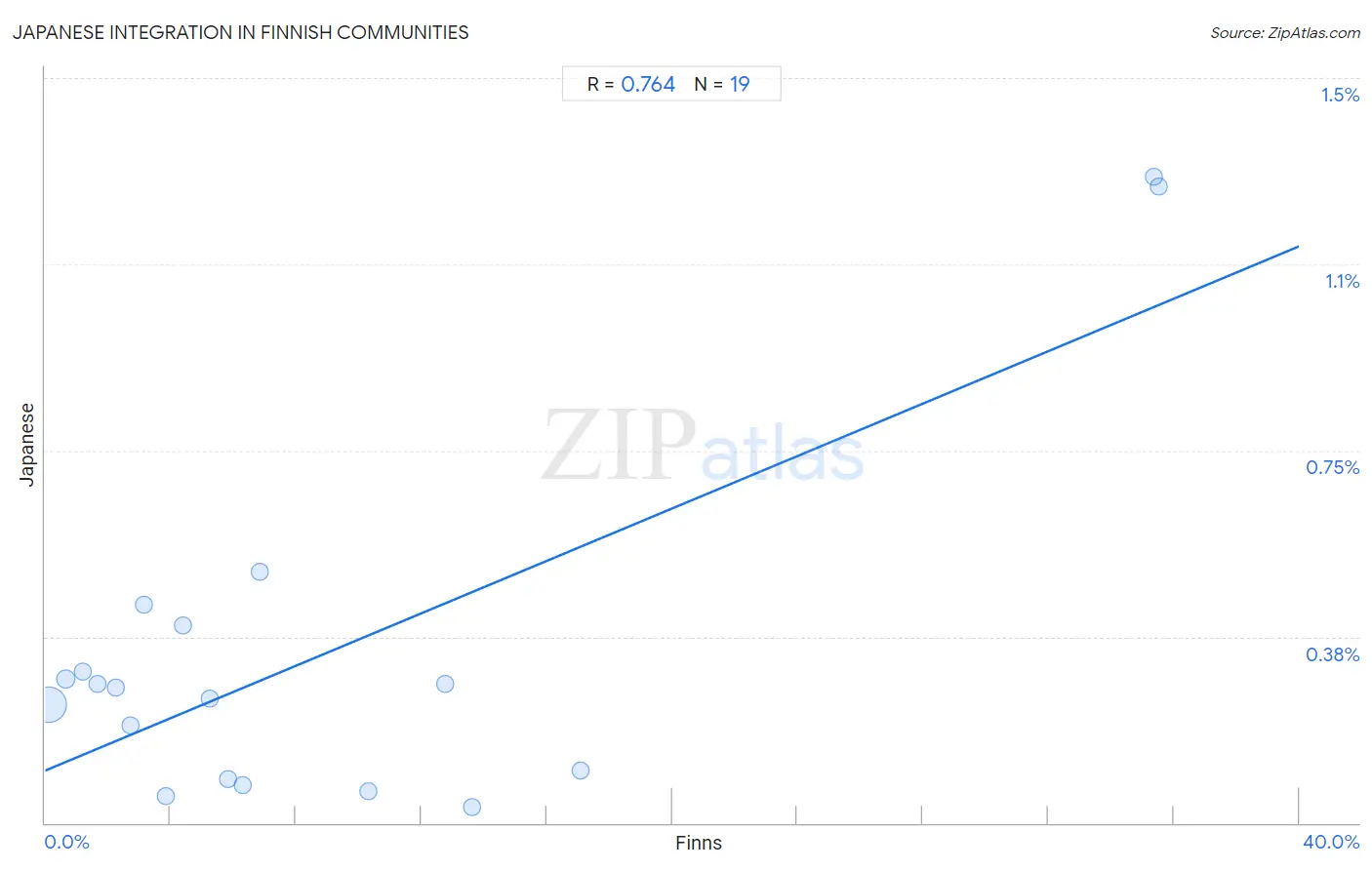
Finnish vs Japanese Income
When considering income, the most significant differences between Finnish and Japanese communities in the United States are seen in wage/income gap (28.6% compared to 23.8%, a difference of 20.2%), per capita income ($43,461 compared to $39,870, a difference of 9.0%), and median male earnings ($54,721 compared to $51,473, a difference of 6.3%). Conversely, both communities are more comparable in terms of median household income ($83,607 compared to $83,395, a difference of 0.25%), median female earnings ($38,173 compared to $38,528, a difference of 0.93%), and householder income under 25 years ($51,827 compared to $52,365, a difference of 1.0%).

| Income Metric | Finnish | Japanese |
| Per Capita Income | Average $43,461 | Tragic $39,870 |
| Median Family Income | Average $102,676 | Tragic $97,288 |
| Median Household Income | Fair $83,607 | Fair $83,395 |
| Median Earnings | Fair $45,940 | Tragic $44,825 |
| Median Male Earnings | Average $54,721 | Tragic $51,473 |
| Median Female Earnings | Tragic $38,173 | Tragic $38,528 |
| Householder Age | Under 25 years | Fair $51,827 | Good $52,365 |
| Householder Age | 25 - 44 years | Average $94,610 | Poor $91,624 |
| Householder Age | 45 - 64 years | Average $99,904 | Poor $96,834 |
| Householder Age | Over 65 years | Poor $59,535 | Tragic $57,919 |
| Wage/Income Gap | Tragic 28.6% | Exceptional 23.8% |
Finnish vs Japanese Poverty
When considering poverty, the most significant differences between Finnish and Japanese communities in the United States are seen in receiving food stamps (10.2% compared to 14.1%, a difference of 38.8%), married-couple family poverty (4.2% compared to 5.6%, a difference of 33.5%), and seniors poverty over the age of 65 (9.4% compared to 12.2%, a difference of 29.6%). Conversely, both communities are more comparable in terms of single female poverty (21.5% compared to 21.3%, a difference of 0.94%), female poverty among 25-34 year olds (13.7% compared to 14.1%, a difference of 2.6%), and single mother poverty (30.0% compared to 28.9%, a difference of 3.7%).
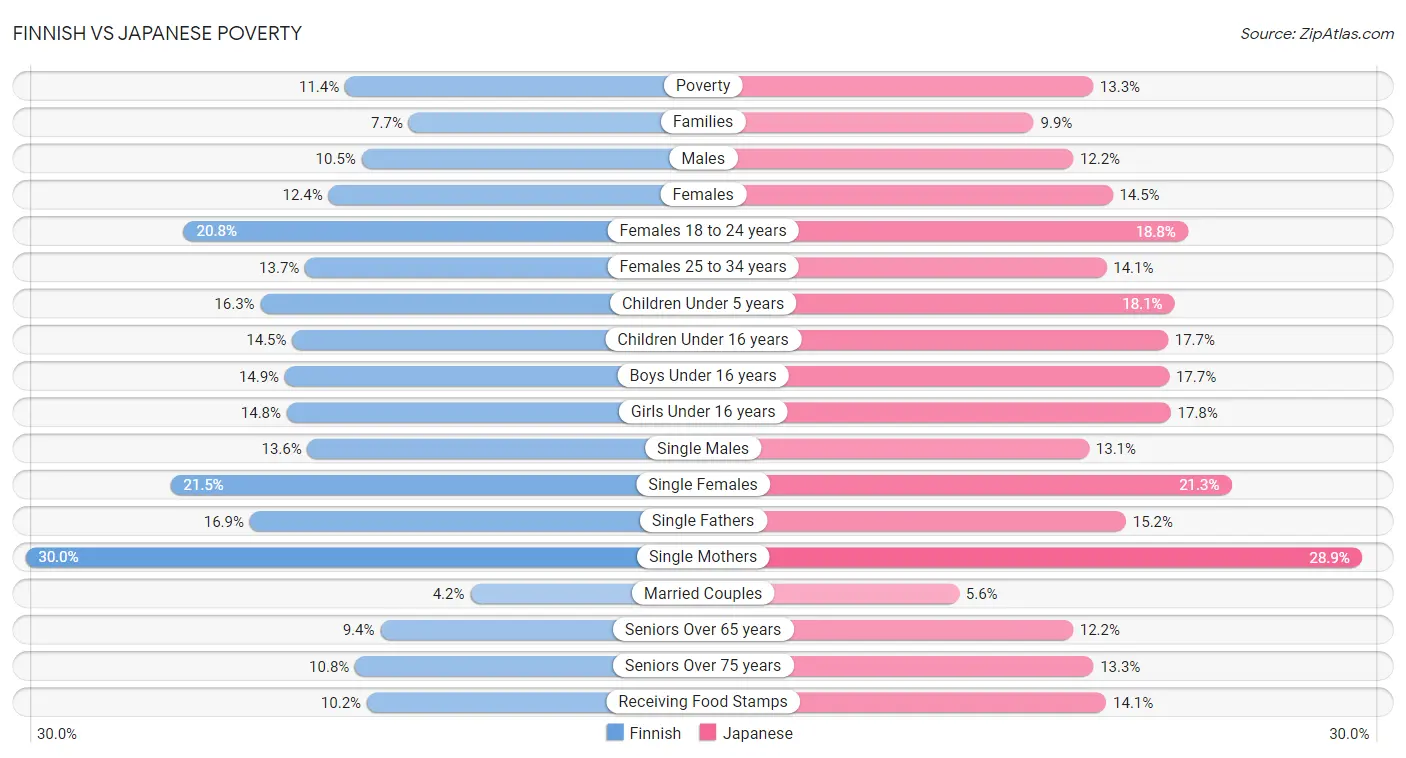
| Poverty Metric | Finnish | Japanese |
| Poverty | Exceptional 11.4% | Tragic 13.3% |
| Families | Exceptional 7.7% | Tragic 9.9% |
| Males | Exceptional 10.5% | Tragic 12.2% |
| Females | Exceptional 12.4% | Tragic 14.5% |
| Females 18 to 24 years | Tragic 20.8% | Exceptional 18.8% |
| Females 25 to 34 years | Fair 13.7% | Poor 14.1% |
| Children Under 5 years | Excellent 16.3% | Poor 18.1% |
| Children Under 16 years | Exceptional 14.5% | Tragic 17.7% |
| Boys Under 16 years | Exceptional 14.9% | Tragic 17.7% |
| Girls Under 16 years | Exceptional 14.8% | Tragic 17.8% |
| Single Males | Tragic 13.6% | Poor 13.1% |
| Single Females | Poor 21.5% | Fair 21.3% |
| Single Fathers | Tragic 16.9% | Exceptional 15.2% |
| Single Mothers | Tragic 30.0% | Good 28.9% |
| Married Couples | Exceptional 4.2% | Tragic 5.6% |
| Seniors Over 65 years | Exceptional 9.4% | Tragic 12.2% |
| Seniors Over 75 years | Exceptional 10.8% | Tragic 13.3% |
| Receiving Food Stamps | Exceptional 10.2% | Tragic 14.1% |
Finnish vs Japanese Unemployment
When considering unemployment, the most significant differences between Finnish and Japanese communities in the United States are seen in female unemployment (4.6% compared to 5.6%, a difference of 21.2%), unemployment among seniors over 75 years (10.0% compared to 8.3%, a difference of 19.8%), and unemployment (4.7% compared to 5.6%, a difference of 19.6%). Conversely, both communities are more comparable in terms of unemployment among ages 65 to 74 years (5.3% compared to 5.2%, a difference of 1.7%), unemployment among seniors over 65 years (5.0% compared to 4.9%, a difference of 2.0%), and unemployment among ages 20 to 24 years (9.7% compared to 10.0%, a difference of 3.0%).
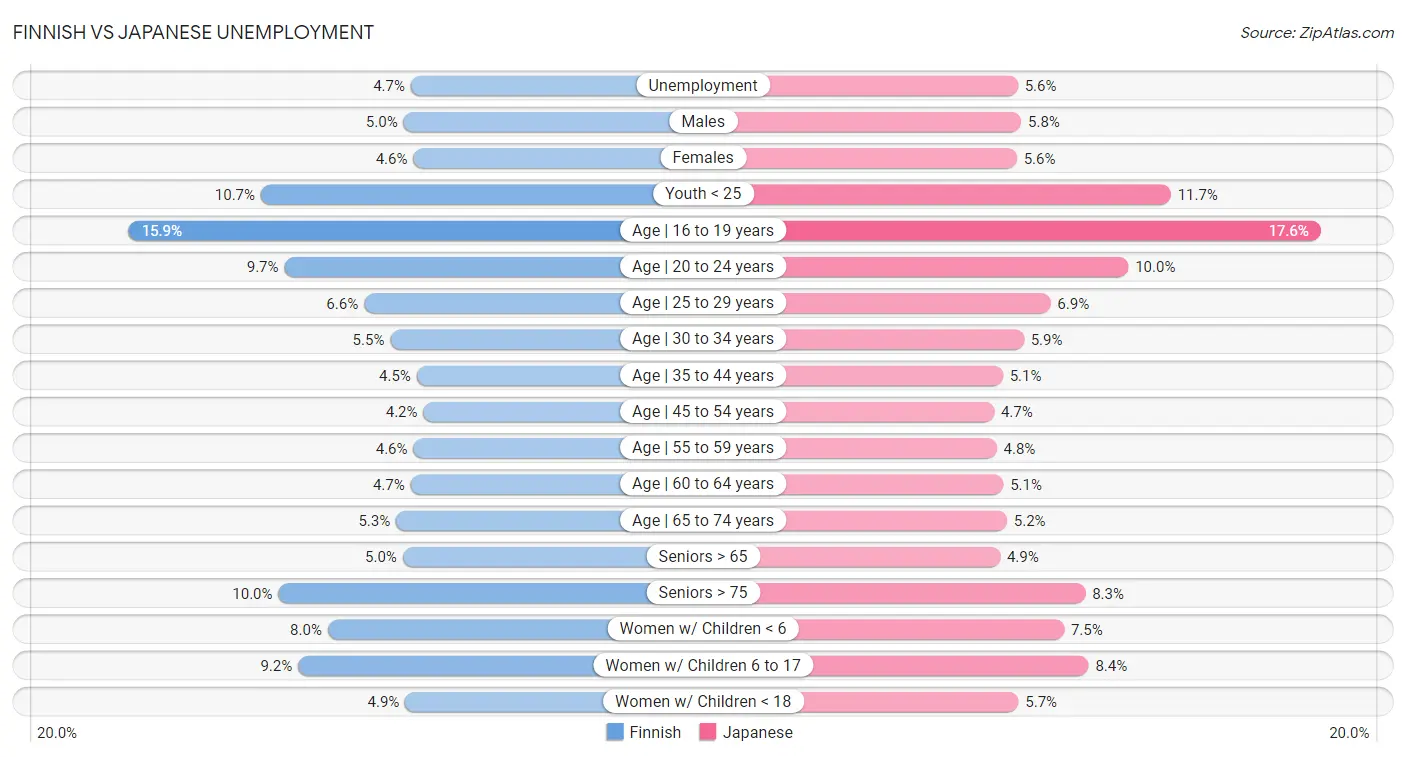
| Unemployment Metric | Finnish | Japanese |
| Unemployment | Exceptional 4.7% | Tragic 5.6% |
| Males | Exceptional 5.0% | Tragic 5.8% |
| Females | Exceptional 4.6% | Tragic 5.6% |
| Youth < 25 | Exceptional 10.7% | Fair 11.7% |
| Age | 16 to 19 years | Exceptional 15.9% | Average 17.6% |
| Age | 20 to 24 years | Exceptional 9.7% | Exceptional 10.0% |
| Age | 25 to 29 years | Good 6.6% | Tragic 6.9% |
| Age | 30 to 34 years | Fair 5.5% | Tragic 5.9% |
| Age | 35 to 44 years | Exceptional 4.5% | Tragic 5.1% |
| Age | 45 to 54 years | Exceptional 4.2% | Tragic 4.7% |
| Age | 55 to 59 years | Exceptional 4.6% | Average 4.8% |
| Age | 60 to 64 years | Exceptional 4.7% | Tragic 5.1% |
| Age | 65 to 74 years | Good 5.3% | Exceptional 5.2% |
| Seniors > 65 | Exceptional 5.0% | Exceptional 4.9% |
| Seniors > 75 | Tragic 10.0% | Exceptional 8.3% |
| Women w/ Children < 6 | Tragic 8.0% | Good 7.5% |
| Women w/ Children 6 to 17 | Tragic 9.2% | Exceptional 8.4% |
| Women w/ Children < 18 | Exceptional 4.9% | Tragic 5.7% |
Finnish vs Japanese Labor Participation
When considering labor participation, the most significant differences between Finnish and Japanese communities in the United States are seen in in labor force | age 16-19 (43.9% compared to 37.5%, a difference of 17.0%), in labor force | age 20-24 (78.7% compared to 75.3%, a difference of 4.5%), and in labor force | age > 16 (64.2% compared to 65.8%, a difference of 2.5%). Conversely, both communities are more comparable in terms of in labor force | age 30-34 (84.7% compared to 84.3%, a difference of 0.41%), in labor force | age 20-64 (79.5% compared to 79.1%, a difference of 0.53%), and in labor force | age 25-29 (85.0% compared to 84.3%, a difference of 0.74%).

| Labor Participation Metric | Finnish | Japanese |
| In Labor Force | Age > 16 | Tragic 64.2% | Exceptional 65.8% |
| In Labor Force | Age 20-64 | Fair 79.5% | Tragic 79.1% |
| In Labor Force | Age 16-19 | Exceptional 43.9% | Excellent 37.5% |
| In Labor Force | Age 20-24 | Exceptional 78.7% | Good 75.3% |
| In Labor Force | Age 25-29 | Excellent 85.0% | Poor 84.3% |
| In Labor Force | Age 30-34 | Average 84.7% | Tragic 84.3% |
| In Labor Force | Age 35-44 | Exceptional 84.7% | Tragic 83.6% |
| In Labor Force | Age 45-54 | Excellent 83.1% | Tragic 81.6% |
Finnish vs Japanese Family Structure
When considering family structure, the most significant differences between Finnish and Japanese communities in the United States are seen in single mother households (5.7% compared to 7.4%, a difference of 30.5%), single father households (2.4% compared to 2.8%, a difference of 14.6%), and births to unmarried women (31.7% compared to 35.2%, a difference of 11.1%). Conversely, both communities are more comparable in terms of family households (63.5% compared to 65.9%, a difference of 3.8%), divorced or separated (12.5% compared to 12.0%, a difference of 4.3%), and married-couple households (48.1% compared to 45.2%, a difference of 6.5%).

| Family Structure Metric | Finnish | Japanese |
| Family Households | Tragic 63.5% | Exceptional 65.9% |
| Family Households with Children | Tragic 26.6% | Exceptional 29.4% |
| Married-couple Households | Exceptional 48.1% | Tragic 45.2% |
| Average Family Size | Tragic 3.09 | Exceptional 3.35 |
| Single Father Households | Poor 2.4% | Tragic 2.8% |
| Single Mother Households | Exceptional 5.7% | Tragic 7.4% |
| Currently Married | Exceptional 48.8% | Tragic 44.5% |
| Divorced or Separated | Tragic 12.5% | Good 12.0% |
| Births to Unmarried Women | Average 31.7% | Tragic 35.2% |
Finnish vs Japanese Vehicle Availability
When considering vehicle availability, the most significant differences between Finnish and Japanese communities in the United States are seen in no vehicles in household (7.7% compared to 9.4%, a difference of 22.9%), 4 or more vehicles in household (7.3% compared to 7.7%, a difference of 5.4%), and 2 or more vehicles in household (60.3% compared to 57.5%, a difference of 4.9%). Conversely, both communities are more comparable in terms of 1 or more vehicles in household (92.4% compared to 90.6%, a difference of 2.0%), 3 or more vehicles in household (22.3% compared to 21.8%, a difference of 2.3%), and 2 or more vehicles in household (60.3% compared to 57.5%, a difference of 4.9%).

| Vehicle Availability Metric | Finnish | Japanese |
| No Vehicles Available | Exceptional 7.7% | Exceptional 9.4% |
| 1+ Vehicles Available | Exceptional 92.4% | Exceptional 90.6% |
| 2+ Vehicles Available | Exceptional 60.3% | Exceptional 57.5% |
| 3+ Vehicles Available | Exceptional 22.3% | Exceptional 21.8% |
| 4+ Vehicles Available | Exceptional 7.3% | Exceptional 7.7% |
Finnish vs Japanese Education Level
When considering education level, the most significant differences between Finnish and Japanese communities in the United States are seen in no schooling completed (1.5% compared to 3.3%, a difference of 129.3%), doctorate degree (1.8% compared to 1.5%, a difference of 19.7%), and professional degree (4.2% compared to 3.5%, a difference of 17.6%). Conversely, both communities are more comparable in terms of nursery school (98.6% compared to 96.7%, a difference of 2.0%), kindergarten (98.6% compared to 96.7%, a difference of 2.0%), and 1st grade (98.6% compared to 96.6%, a difference of 2.0%).
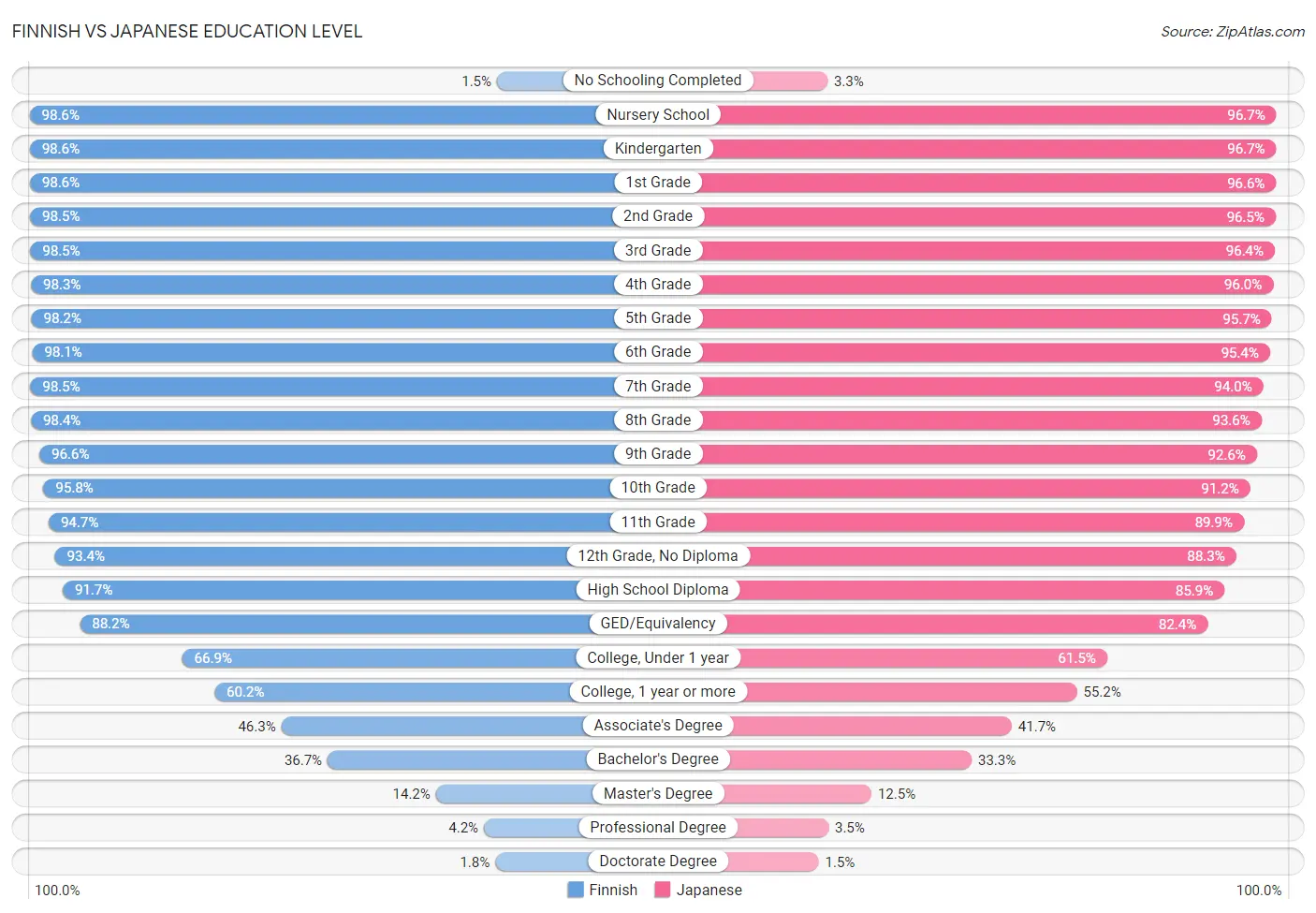
| Education Level Metric | Finnish | Japanese |
| No Schooling Completed | Exceptional 1.5% | Tragic 3.3% |
| Nursery School | Exceptional 98.6% | Tragic 96.7% |
| Kindergarten | Exceptional 98.6% | Tragic 96.7% |
| 1st Grade | Exceptional 98.6% | Tragic 96.6% |
| 2nd Grade | Exceptional 98.5% | Tragic 96.5% |
| 3rd Grade | Exceptional 98.5% | Tragic 96.4% |
| 4th Grade | Exceptional 98.3% | Tragic 96.0% |
| 5th Grade | Exceptional 98.2% | Tragic 95.7% |
| 6th Grade | Exceptional 98.1% | Tragic 95.4% |
| 7th Grade | Exceptional 98.5% | Tragic 94.0% |
| 8th Grade | Exceptional 98.4% | Tragic 93.6% |
| 9th Grade | Exceptional 96.6% | Tragic 92.6% |
| 10th Grade | Exceptional 95.8% | Tragic 91.2% |
| 11th Grade | Exceptional 94.7% | Tragic 89.9% |
| 12th Grade, No Diploma | Exceptional 93.4% | Tragic 88.3% |
| High School Diploma | Exceptional 91.7% | Tragic 85.9% |
| GED/Equivalency | Exceptional 88.2% | Tragic 82.4% |
| College, Under 1 year | Excellent 66.9% | Tragic 61.5% |
| College, 1 year or more | Good 60.2% | Tragic 55.2% |
| Associate's Degree | Average 46.3% | Tragic 41.7% |
| Bachelor's Degree | Fair 36.7% | Tragic 33.3% |
| Master's Degree | Poor 14.2% | Tragic 12.5% |
| Professional Degree | Poor 4.2% | Tragic 3.5% |
| Doctorate Degree | Average 1.8% | Tragic 1.5% |
Finnish vs Japanese Disability
When considering disability, the most significant differences between Finnish and Japanese communities in the United States are seen in disability age under 5 (1.6% compared to 1.2%, a difference of 35.0%), hearing disability (3.7% compared to 3.0%, a difference of 22.6%), and disability age 18 to 34 (7.8% compared to 6.8%, a difference of 14.6%). Conversely, both communities are more comparable in terms of disability age 5 to 17 (6.0% compared to 6.1%, a difference of 0.38%), ambulatory disability (6.2% compared to 6.3%, a difference of 0.55%), and female disability (12.8% compared to 12.6%, a difference of 1.7%).
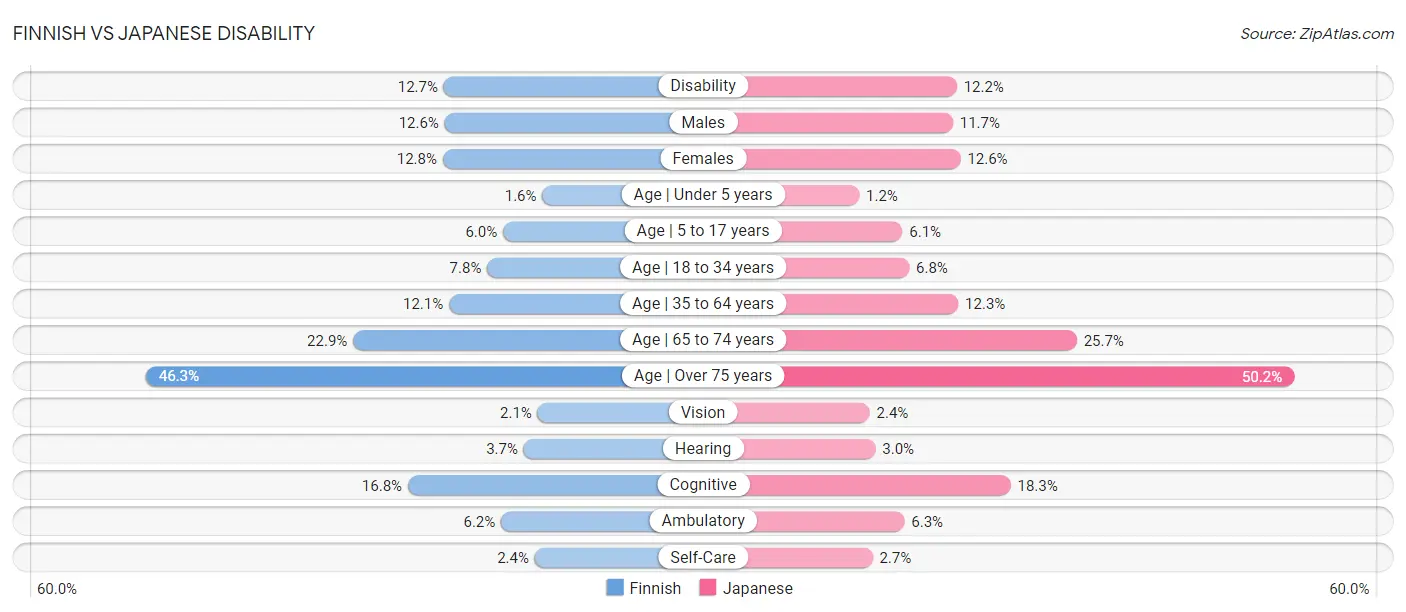
| Disability Metric | Finnish | Japanese |
| Disability | Tragic 12.7% | Tragic 12.2% |
| Males | Tragic 12.6% | Tragic 11.7% |
| Females | Tragic 12.8% | Tragic 12.6% |
| Age | Under 5 years | Tragic 1.6% | Exceptional 1.2% |
| Age | 5 to 17 years | Tragic 6.0% | Tragic 6.1% |
| Age | 18 to 34 years | Tragic 7.8% | Poor 6.8% |
| Age | 35 to 64 years | Tragic 12.1% | Tragic 12.3% |
| Age | 65 to 74 years | Good 22.9% | Tragic 25.7% |
| Age | Over 75 years | Exceptional 46.3% | Tragic 50.2% |
| Vision | Good 2.1% | Tragic 2.4% |
| Hearing | Tragic 3.7% | Average 3.0% |
| Cognitive | Exceptional 16.8% | Tragic 18.3% |
| Ambulatory | Poor 6.2% | Poor 6.3% |
| Self-Care | Good 2.4% | Tragic 2.7% |